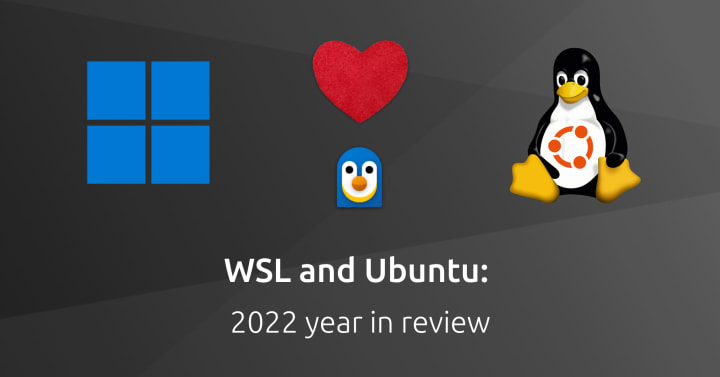WSL and Ubuntu: 2022 year in review
In 2022, Windows Subsystem for Linux (WSL) exploded in popularity, with millions of users taking advantage of the ability to develop, create and administrate inside a native Linux environment deeply integrated with Windows.
This is thanks in large part to continued investment from Microsoft, consistently rolling out new features and updates for the platform on both Windows 10 and Windows 11. As the most popular distribution for WSL, the Ubuntu team is committed to supporting and building on these features to ensure that we deliver a polished and powerful Ubuntu WSL experience.
We’re looking forward to enhancing Ubuntu WSL in 2023 with new features for enterprise users and developers. But for now let’s take a look back at our 2022 highlights and round up all of the changes and updates that landed in the last 12 months!
To kick things off, check out Microsoft PM Craig Loewen’s Ubuntu Summit talk on the past, present and future of WSL.
April: Tools and Tutorials for Data Scientists
For Data Scientists and AI/ML engineers working in a Windows-centric institution, WSL provides them with access to the full suite of open source data science tools optimised for Linux, including PyTorch, Tensorflow and scikit-learn. Thanks to WSL’s integration with the host machine they can spin up Python notebook environments in Linux and develop with them in their Windows browser or VS Code. Linux distributions in WSL also have access to the machine’s GPU via native Windows drivers, meaning frameworks like NVIDIA CUDA can take full advantage of your hardware with minimal performance impact when running inside Linux on Windows.
We’ve put together a number of pieces looking at data science workflows in Ubuntu WSL, including our Webinar from April 2022, and the following whitepapers and tutorials.
Webinar: Ubuntu on WSL: An FAQ for Data Scientists and Developers
Whitepaper: Ubuntu WSL for Data Scientists
Tutorial: Setting up NVIDIA Cuda with Ubuntu on WSL
Blog: Upgrade your data science workflows with Ubuntu WSL
For more insight into other users of WSL, check out the Stack Overflow section later in this post.
May: Ubuntu Preview is released on the Windows Store
The default Ubuntu application on the Microsoft Store always provides the latest LTS release of Ubuntu after the first point release (for example Ubuntu 22.04.1 LTS and later). Previous Ubuntu LTSs are also available to install for users who want to remain on a particular release; these provide a stable development base for users, with over five years of Long Term Support.
Ubuntu Preview, launched in May 2022, now delivers the latest daily builds of Ubuntu to WSL users and offers a way for developers to experiment with the latest toolchains and features available in interim or upcoming Ubuntu releases. It is not designed for production development but for those happy to explore and report issues they encounter to help improve future releases of Ubuntu.
Get Ubuntu Preview from the Microsoft Store
November: WSL2 transitions to the Windows Store App on Windows 10
Over the past 18 months, the Windows 10 and Windows 11 implementations of WSL2 had diverged significantly. Windows 11, delivering WSL as a Windows Store application, was able to move more quickly and include additional features such as WSLg and Systemd support ahead of the Windows feature-based implementation in Windows 10.
That ended in November as Windows 10 finally migrated WSL2 to a Windows Store application, unifying the Windows 10 and 11 experience.
Now, regardless of your Windows version, you can install WSL via the Windows Store, or by running wsl --install in Powershell (or wsl --update if you want to upgrade an existing version).
With this change, new updates can be delivered more quickly to all Windows users, meaning the pace of progression for WSL is only going to increase going into 2023.
Keep in touch for the latest Ubuntu WSL news
As you can see, 2022 was a transformative year for WSL with the addition of key foundational features alongside a significant growth in developer adoption. In 2023 we’ll continue to publish informative content to help developers get the most out of Ubuntu WSL. In addition we’ll be focussing on enterprise features to help IT administrators securely enable Linux developers whilst remaining a part of their organisation’s existing Windows ecosystem.
We’ll close this blog with a final video from Edu Gomez Escandell with his recent introduction to numerical computation applications using WSL and some links on how to get started.
To stay up to date with news, tutorials and guides sign up to our newsletter using the form on the right!
Getting started:
Tutorial: Install Ubuntu on WSL2
Tutorial: Window and Ubuntu interoperability
Tutorial: Working with VS Code on Ubuntu WSL
Find out more at Ubuntu.com/wsl





Comments
Post a Comment